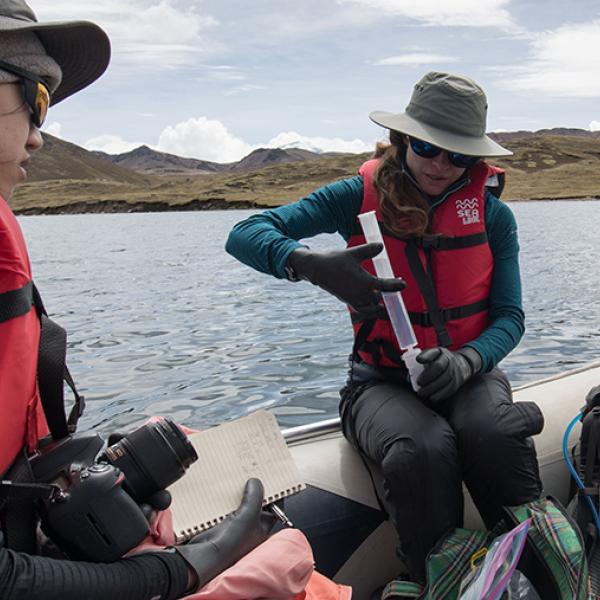Biologist Himadri Pakrasi, director of Washington University's International Center for Energy, Environment, and Sustainability, has been studying tiny creatures called cyanobacteria for more than 25 years. He shares what we know about cyanobacteria, and how they may hold clues to understanding our world's environment and creating a more sustainable future.
Transcript:
Claire Gauen (host): Thanks for listening to Hold That Thought. I’m Claire Gauen. Now we’ve all heard of bacteria – the tiny organisms that live inside our bodies and all around us. But have you ever heard of cyanobacteria? If you haven’t, don’t worry – biologist Himadri Pakrasi is here to tell us all about these bluish-green, microscopic, incredible creatures.
Himadri Pakrasi (guest): I am Himadri Pakrasi. I'm a professor in the biology department.
CG: Pakrasi also directs WashU’s International Center for Energy, Environment and Sustainability, or InCEES. He’s been studying cyanobacteria for more than 25 years, and when you ask him to talk about cyanobacteria, he quickly begins using words like ‘amazing’ and ‘remarkable.’ So what makes them so amazing? Without further ado, here’s Pakrasi to explain.
HP: OK so let's start with a little bit of background. Cyanobacteria, because they only need sunlight and carbon dioxide and just water, they can grow anywhere. They have been found all over the planet - very hot, very cold, very dry, very wet, on water bodies, as well as on solid surfaces.
"In many ways, we owe it to these these little creatures the way we conduct our lifestyle. So from that point of view, cyanobacteria are amazing."
CG: Wherever they’re found, they only need sunlight, carbon dioxide, and water because like plants, cyanobacteria do photosynthesis – or convert sunlight into a usable form of energy. In fact, they were doing photosynthesis long before plants. Cyanobacteria have been more than 2 billion years, back to when the Earth had far less oxygen than it does today. So, the fact that they create oxygen through photosynthesis was a really big deal.
HP: So cyanobacteria are the ones who first showed this planet how to take water and make oxygen out of it, and that oxygen is what changed entire atmosphere. You and me and everybody else, all the other animals and all the other non-photosynthetic organisms - we depend on oxygen, because oxygen is needed for respiration. So in many ways we owe it to these these little creatures the way we conduct our lifestyle. So from that point of view, cyanobacteria are amazing.
CG: So, as your taking a breath right now, take a moment to thank cyanobacteria. Are you convinced they’re amazing yet? No? Okay, let’s see if this does it.
HP: Some cyanobacteria can also do another amazing biochemical reaction, and that's nitrogen fixation.
CG: Nitrogen fixation. This is the process of taking nitrogen gas, which makes up more than three-fourths of Earth’s atmosphere, and turning it into a form that it can be used by plants and animals. This is really important because all living things on earth need nitrogen to grow. It’s one of the major building blocks that makes up things like proteins. There are different kinds of bacteria that can fix nitrogen, but it’s especially impressive that some cyanobacteria can do it. Remember how cyanobacteria create oxygen? When it comes to fixing nitrogen, there’s a bit of a problem with that.
HP: Oxygen is a poison for nitrogenase, the enzyme that fixes nitrogen. So we were facing this challenge, that Cyanobacteria are doing these impossible two different processes. They're are conducting those - how is this happening?
CG: Just to make sure you got that – the special enzyme that fixes nitrogen, called nitrogenase, can’t handle oxygen. Oxygen equals poison. Some other types of bacteria that fix nitrogen solve the whole “oxygen is poison” problem by hiding inside the roots of plants like soybeans. Cyanobacteria, however, have another method. Instead of physically separating nitrogenase from oxygen, these one-celled creatures figured out another way – separation through time.
HP: The key was that cyanobacteria turns out to be the only bacteria with circadian rhythms, just like you and me.. They can gauge the day and the night very nicely. So what they do is, during the time the sun is on they do photosynthesis. At nighttime, they use the products of photosynthesis as a source of energy to conduct nitrogen fixation. See at nighttime, there is no photosynthesis. So time is the gatekeeper to conduct these two apparently contradictory processes, both of which are fairly important. One that fixes carbon, makes oxygen, the other one that fixes nitrogen.
"The key was that cyanobacteria turns out to be the only bacteria with circadian rhythms, just like you and me. They can gauge the day and the night very nicely ... Time is the gatekeeper."
CG: Pakrasi and his colleagues have spent some 15 years looking in detail at what is happening here, even sequencing the genome of these special cyanobacteria. You might think in that amount of time they’d learn all there is to know, but that is not even close to being true. Pakrasi’s lab currently has multiple ongoing projects related to cyanobacteria – we’re going to spend a bit of time talking about one of these. Right now, his group is in the middle of a unique 2-year effort, funded by the Gordon and Betty Moore Foundation. It all started in the middle of the ocean.
HP: Now another group from UC Santa Cruz led by Professor Jonathan Zehr, a very well known name in oceanography - he made a big discovery in oceanic nitrogen fixation. He was asking a very simple question. In the ocean there are a lot of different kinds of organisms that grow, and they all need fixed nitrogen. Where they're getting it from? And the answer was some form of a sign of a cyanobacterium. So he discovered the cyanobacterium, and that one he called U-C-Y-N-A, or UCYN-A. There is also a twist in this. That cyanobacterium is a crippled cyanobacterium. UCYN-A cannot do what I just described all cyanobacteria do, which is UCYN-A cannot produce oxygen.
CG: Zehr had found a mystery. Without the ability to do photosynthesis, how do these crippled cyanobacteria survive? Over time, he found that UCYN-A does have a way. They just can’t do it alone.
HP: UCYN-A actually hooks it itself up to a photosynthetic alga, and that alga fixes carbon and the UCYN-A fixes nitrogen. And so there is a division of tasks.
CG: Otherwise known as a symbiotic relationship. In order study this unique biological teamwork, a couple years ago Pakrasi and Zehr decided to also combine forces.
HP: We wanted to go much deeper into unraveling the mysteries of this symbiotic process. Very little is known because these cells are rare. In the ocean, in a liter of seawater you find about a thousand such cyanobacteria if you are lucky. This is in comparison to in our lab, we deal typically with a hundred million to a billion cyanobacterial cells. So there is a big difference in the density of the cells that can be found. And that's why we come in. We are aiming at stabilizing these interactions between the two kinds of organisms. We are trying to determine how we can grow them in larger quantities. And, we are very interested in figuring out the structures of these organisms at the ultrastructural level. So that's the genesis of this project. It's a completely out of the box and extremely risky project, and that's one of the reasons that the Gordon and Betty Moore Foundation funded this project.
"We wanted to go much deeper into unraveling the mysteries of this symbiotic process. Very little is known because these cells are rare."
HP: Typically nowadays, when federal agencies fund a project, we usually say 'I can do this, and let me go and do the next thing.' In this case, it's not at all certain that we'll ever be able to grow in large quantities these cultures. These cultures may, or these cells may, actually be un-culturable. That's a distinct possibility. And if that happens, then this project may not result in significant new findings. So in that way it's a risky.
CG: By risky, Pakrasi doesn’t mean dangerous or anything like that. He explained that in this type of project, results are uncertain – and in many cases, it’s hard to get money for risky research.
HP: What we will be able to do is, unlike the traditional microscopy techniques where you are looking at still pictures of organisms, here we'll be able to track individual cells and assay based on the fluorescence properties their photosynthetic activities, as well as nitrogen fixation activities. So this is going to be an exciting new technology development. No matter what happens with the biology part of it, we are sure that this new technology will be very useful for other researchers elsewhere. So we are we are taking down the risk a little bit.
It’s worth the risk, he says, for a couple of reasons. First, even if Pakrasi’s lab ended up not successfully growing these cells in large quantities, the new technology they’ve developed to do this work is important in itself.
HP: This is a global nitrogen fixation story, and we have very little idea of what's going on there. So from a fundamental biology kind of question, it's an interesting one to pursue. In the ocean-level biological nitrogen fixation story, this is an important thing that has eluded investigations over the last two hundred years that people are looking at organisms in the ocean. Now if we understand the mechanisms of how this is working, then that's going to contribute to our understanding of the ocean as an ecosystem.
"In the ocean-level biological nitrogen fixation story, this is an important thing that has eluded investigations over the last two hundred years. "
CG: Then of course there’s the possibility that it does work. By learning about algae and UCYN-A’s unique symbiotic relationship, Pakrasi and Zehr would help solve part of a much larger puzzle.
HP: The important thing is that through this kind of experiments then, one hopes that one could learn the design principles, as they are called, so that eventually those can be applied to create or engineer plants that are nitrogen fixing.
CG: And, as big as that is, the story doesn’t stop there. Understanding the ecosystem of the ocean – how plants, algae, and bacteria have worked together to sustain life for longer than any of us can imagine – may also provide clues for how to eventually create and promote similar processes on land.
HP: Ultimately, in agriculture, a big goal now is to engineer crop plants so that they can fix their own nitrogen. Now this is already done by the beans. Soybeans, they have these nodules in which there are bacteria that reside, and they can fix nitrogen. That process is well studied. But another way the same goal can be achieved is if we can engineer the nitrogen-fixing apparatus directly into the photosynthetic tissues of crop plants.
CG: In particular, nitrogen-fixing plants that provide food.
CG: At least in theory, such engineered plants could help make agriculture much more sustainable. For decades, farmers have used synthetic nitrogen to fertilize their crops. Too much nitrogen contributes to major environmental problems, like the huge so-called ‘dead zones’ in the waters of the Chesapeake Bay and elsewhere. By limiting the use of nitrogen fertilizers, years from now, plants that fix their own nitrogen could be a sustainability game-changer. As director of the International Center for Energy, Environment, and Sustainability, that’s something that Pakrasi deeply cares about. It’s one of the many reasons that for the past 25 years he’s remained so fascinated with the amazing, blue-green, sustainable creatures known as cyanobacteria.
HP: The day we can figure out how these organisms are doing what they're doing - how is it that they're assembling these machines that are involved in production of oxygen; how is it they're capturing CO2 in an efficient way; and how is it they are not leaving behind harmful products? If we can emulate that in biology, as well as in engineered materials sciences, I think we are going to win the sustainability challenge. There is no question in my mind.
CG: Many thanks to Himadri Pakrasi for joining Hold that Thought. For many more ideas to explore, please sure to visit our website holdthatthought.wustl.edu and subscribe. Thanks for listening.




